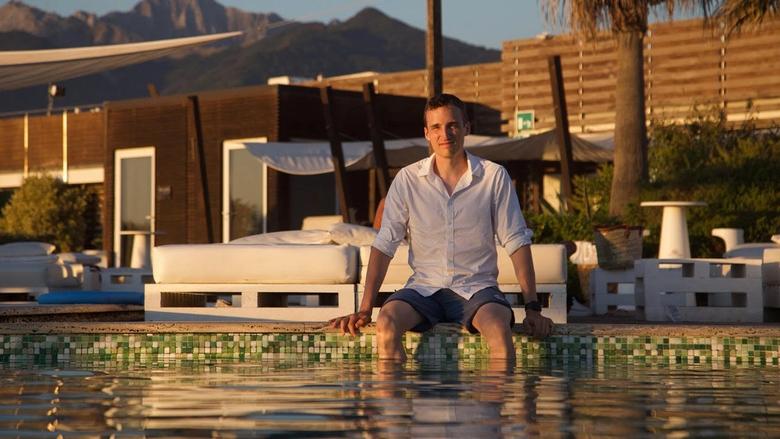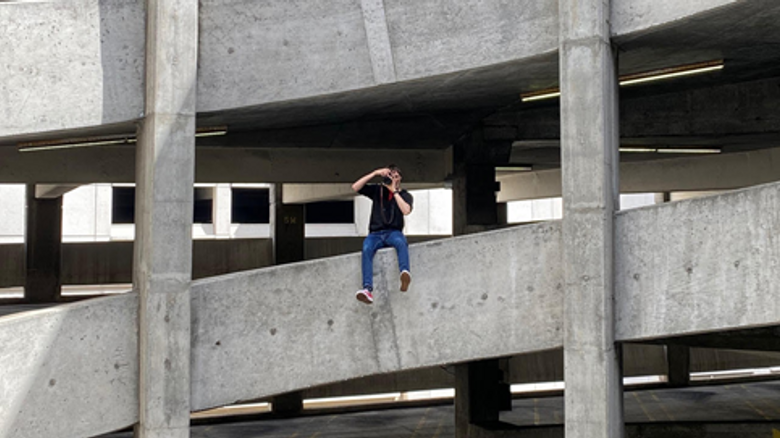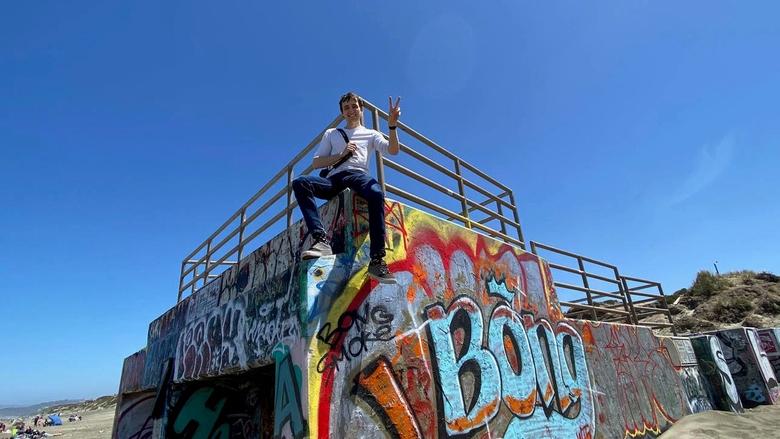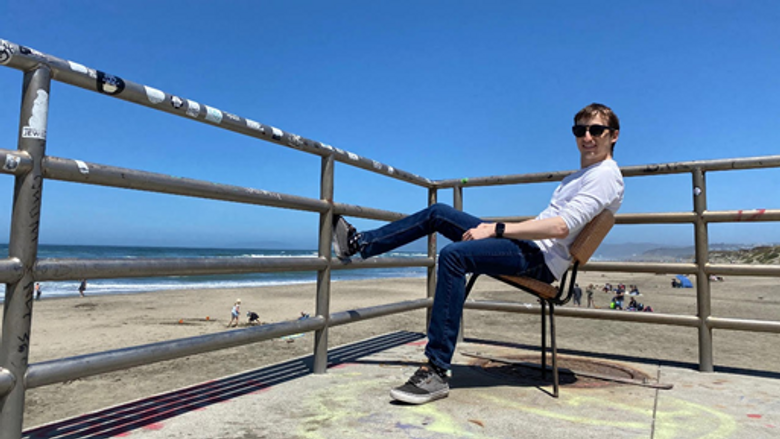Tony Aubé: Making Tech More Accessible
Meet Tony Aubé, experienced product designer and content creator.
From Canada to Silicon Valley

Tony Aubé always knew what he wanted to do in life.
In elementary school, Aubé found his interests at the intersection of art and computers. While his friends said they wanted to be hockey players and astronauts, Aubé had written in the yearbook that he wanted to “draw on computers.” And although he didn’t know the name for it quite yet, he knew he wanted to be a designer.
During high school, Aubé spent a lot of time playing video games, which sparked his interest in game design. He enrolled in a graphic design program in college, which ended up being far more challenging than he anticipated. He was close to dropping out of the program when he realized his poor performance stemmed from being too objective and logical. Aubé found that graphic design required a more abstract and emotion-based mindset. He eventually fell in love with web design, which was a perfect balance of objectivity and subjectivity.

“Web design was a good mix of art and subjectivity, but also, something you can quantify and be logical about,” he said.
Aubé grew up in Québec, Canada, surrounded by a large family. His father has 12 siblings, and he is one of seven siblings. Out of his family, he has been the only one to leave Canada and move to the United States. Originally he only spoke French, but he learned English and came to Silicon Valley to pursue his passion for design.
“I just love it. I don't know how to say it. I would do it for free,” he said about design. He later added, “It's both creative, but it also can have a big impact on people's lives. It's a merging of everything I like.”
Aubé's Career
Aubé has spent the bulk of his career at Osmo, an educational gaming platform for kids. Through this platform, kids can play games and listen to music in a hands-on learning environment. It simulates real-world activities through games where kids can keep score, receive feedback and play through levels.
While working for Osmo, Aubé has seen the small startup grow into a much bigger company. Aubé joined in 2014 as the organization's first designer. During his first six years at Osmo, he designed the website, the games and expanded their branding.

“I can do every design-related task, which is very useful when you work for startups because everything needs to be done,” he said.
In 2019, Aubé left Osmo to work as a senior product designer for Google AI. While at Google, Aubé worked on improving the Google Home experience. Through the use of cameras, he sought to make life at home a more interactive experience for users. After a year, Aubé returned to Osmo as a principal designer, which allowed him to explore more leadership opportunities.
Aubé says the biggest misconception about designers it that they just “do a paint job” to make products look pretty. But design has to be there from the beginning: from brainstorming to deciding features and working with team members.
“At the very end, you make it pretty, and you make it pleasing and fun. But there's this 80% of the job that people don't really know about,” he said.
Through His Lens

Education Through Social Media
Aubé admits photography wasn’t his strong suit in college. When he first joined Osmo, he was asked to do photography for the company and eventually started to enjoy it. He embraced how photography and web design shared a lot of similar principles. And noted that “every creative job relates to each other in some ways.”
Using Instagram helped Aubé delve into photography as a hobby too. With Instagram’s platform, he’s able to share his photos of traveling and the wilderness. Through photography, he found himself fascinated by making videos and has recently been using TikTok to teach people about tech and design. TikTok is efficient because the videos are shorter than Youtube videos, and are even more direct and to the point.
To Aubé, TikTok is more than just a social media platform for teenagers. He sees the potential of a strong design and tech community growing on this app and is determined to make it happen. The app might not have the best reputation, especially among older generations. But he has seen how his videos can reach younger audiences and make a difference in their lives by educating them about the tech industry. Similar to Twitter, the platform becomes much more valuable when you find the right people to follow, in Aubé’s opinion.

“There are so many young people that don't know what they want to do in their life. When they see one of my videos, they learn about design and then they can consider doing that in the future,” he said.
Aubé’s TikTok videos include topics like negotiating your salary at Google or tips for improving your portfolio as a designer. He has even written about TikTok on Medium, along with a number of other articles about the tech and design industry. In addition, he has spoken at numerous conferences in Canada, France and the United States.

Adapting to COVID-19
He found his hour-long commute from San Francisco to Palo Alto pretty exhausting prior to quarantine. During his morning train rides to work, he’d plan out the day and get ready for the numerous meetings ahead. But sometimes, Aubé would try to find a space that would allow him to focus on himself and his personal projects.
During the pandemic, the entire company transitioned to working from home. It was hard adapting to this new lifestyle because Aubé found he had trouble striking a work-life balance.
Aubé would wake up and start working immediately in bed, eventually move to the couch and work until the late evening. He wanted to stay flexible in order to attend meetings with international coworkers, which also impacted this balance.
“It gets a little bit depressing staying inside all the time,” he said.
But upon creating and committing to a more defined schedule, Aubé has been able to enjoy working from home. During meetings, he’ll even go on walks just so he can be outside as much as he can. He implemented restrictions, like what time he closes Slack and stops checking his emails. Recently, he’s been trying to go an entire day without checking his email, and instead focuses on completing other tasks. For him, these guidelines have helped improve his productivity while he’s stayed home in Québec.

“I'm just outside under the sun. And it’s turned my worst day of the week into my best day of the week,” Aubé said about having meetings outside.
Connecting With Users

The Importance of User Empathy
Clients often came into Osmo surprised to see a tech company full of kids running around and testing products. Before the pandemic, every Thursday was dedicated to inviting children to give critical feedback on prototypes, new games and test trials Osmo had been working on.

“It’s important to be able to empathize with the people you're building for. And it's almost impossible to understand someone unless you meet them personally,” he said.
Technology allows you to reach millions of people in a short amount of time. Although he finds it fun, Aubé recognizes that design is a powerful part of that process. He places a big focus on empathy and what people need.
“You tend to forget that the stuff you build can have a real impact on people's lives.”
Diversity in Tech
As a designer, Aubé also recognizes the need for a diverse team of designers from “different cultures, different backgrounds, different everything” in order to build effective products for people. With diversity, you have a better ability to connect with your users.
When it comes to diversity, Aubé hones in on the multitude of backgrounds and cultures. He looks at where you’ve come from, how you were brought up and digs deep into the background that makes you unique.

“That's how you will get a very diverse team that has so many different opinions, which can build really interesting products,” he said.
But Aubé sees how much deeper the lack of diversity in the tech industry goes. Early education is a key component for making jobs in the tech industry more accessible. He recalls how in design school, about 90 percent of his classmates were women. After graduation, most of the men went into tech, but very few of the women considered it.
While most people in the San Francisco Bay Area are aware of the great opportunities in tech, people in more remote areas often don’t get a chance to hear about these positions and companies. Aubé uses his social media platforms to talk about and promote these opportunities to a larger demographic.
“I try to promote design to as many people as possible,” he said. He later added, “There is talent all around the world, we just have to get them interested in it early enough.”
👉 Read Next: A recruiter's view on promoting diversity
A Part of Something Bigger

It’s okay to be worried about finding a job in Silicon Valley. When Aubé talks to young designers, he recognizes this fear but advises they first learn technical skills, like how to use design software, until they can create visuals and graphics. Then, focus on building a portfolio of solid and beautiful projects. When it comes to portfolios, strong visual design is what will get them noticed first.

“Visual design gets you the interview, and once you get the interview, your creative process gets you the job,” Aubé said.
Aubé understands that going into art comes with the stereotype that there’ll be a lot of struggles. But he sees design as a good example of an artistic endeavor that has “a lot of demand with great pay and great benefits.” When he sees his product being used by people, Aubé doesn’t doubt this is what he is supposed to do.
“Sometimes I go into the mall and I see an Osmo stand, and there are some kids playing the game and enjoying it. And then you can tell yourself, ‘I was part of that,’ and ‘I created that experience’,” he said.
👉 Here is where you can find Tony Aubé’s Youtube, website and LinkedIn
The information provided herein is for general informational purposes only and is not intended to provide tax, legal, or investment advice and should not be construed as an offer to sell, a solicitation of an offer to buy, or a recommendation of any security by Candor, its employees and affiliates, or any third-party. Any expressions of opinion or assumptions are for illustrative purposes only and are subject to change without notice. Past performance is not a guarantee of future results and the opinions presented herein should not be viewed as an indicator of future performance. Investing in securities involves risk. Loss of principal is possible.
Third-party data has been obtained from sources we believe to be reliable; however, its accuracy, completeness, or reliability cannot be guaranteed. Candor does not receive compensation to promote or discuss any particular Company; however, Candor, its employees and affiliates, and/or its clients may hold positions in securities of the Companies discussed.
